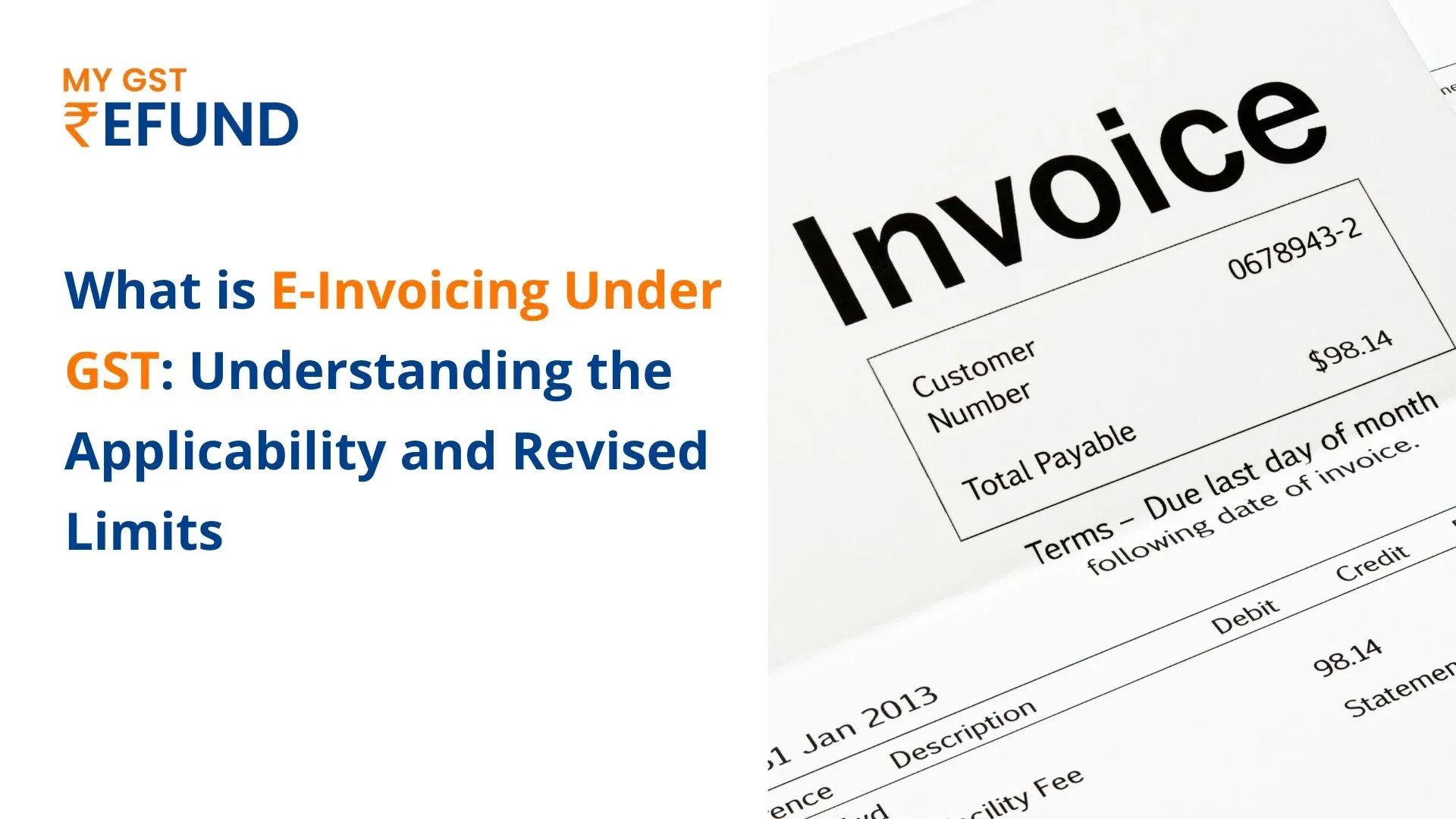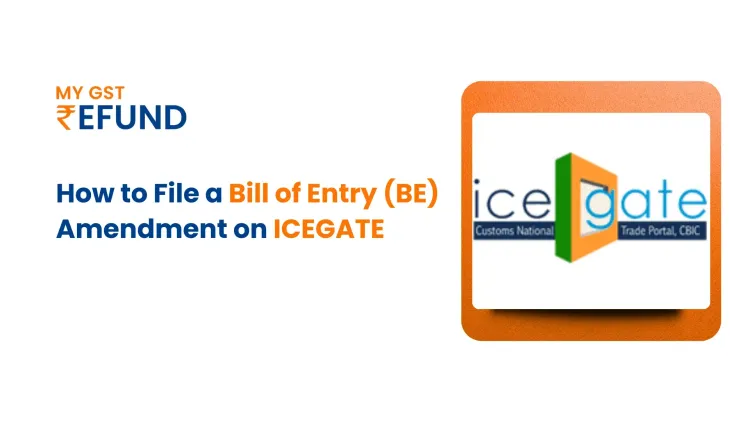E-Invoicing under GST: Applicability & Revised Limits
Published on: Sat Nov 18 2023
What is E-Invoicing Under GST
As most countries across the globe are digitizing their taxation systems, the GST framework of India has also advanced to introduce new mechanisms for easy compliance. One such initiative is e-Invoicing under GST, which is a game-changer. E-invoicing seeks to standardise invoices, documents, and processes through the use of various technologies and taxation measures.
Any business entity operating in India must comply with the requirement under law for e-invoicing. This blog explains what e-invoicing is and who is it applicable to, and other essential updates that will help businesses in the overall GST ecosystem.
What is e-Invoicing Under GST
E-invoicing refers to the electronic invoicing system introduced under the GST regime in India, whereby invoice generation took place in the prescribed format. The Invoice Registration Portal (IRP) checks the authenticity of these invoices through GSTIN. Once the Invoice Reference Number is generated, the IRP digitally signs the invoice making it a valid GST invoice.
The main purpose of e-invoicing is to create a standard template for invoices that can be recognised universally. This system helps to avoid discrepancies, where errors can take place and also to track. The system has GST portal integration so that it will automatically report invoice details. Thus, there is no need for manual entry while filing a GST return.
The essential features of the GST e-invoice system are:
Standardization: There will be a common invoice format, mandated by the government, that businesses will have to adopt.
E-invoices auto-populate data in the GST returns and reduces manual work
Integration: Connection with E-Way Bill and input tax credit (ITC) validation to provide assist.
GST e-invoice system bridges the gap between businesses and regulators, resulting in an ecosystem of trust.
Applicability of e-Invoicing Under GST
It is dependent on the total turnover of the businesses that e-invoicing applies. E-invoicing was first launched for big firms in October 2020, and it has been extended to smaller firms gradually. Below, we have mentioned e-invoice applicable criteria.
Key Applicability Criteria:
Turnover Threshold: As per the recent updates, If any prior financial year the aggregate turnover of the business exceeds ₹ 5 crore, then e-invoicing is mandatory. The initial threshold of ₹500 crore has been steadily lowered over the years to cover greater number of taxpayers.
Entities Covered: General taxpayers i.e. taxpayers who are registered under GST for supply of goods or services, Exporters and Special Economic Zone (SEZ) units.
3. Exemptions: Some e-invoicing requirements don’t apply to banks,financial institutions, government departments and such similar entities.
It’s imperative to know if you are required to comply with the e-invoicing limit in GST on time. If GST returns are not filed on time, it may attract penalties and disrupt your business operations like claiming ITC and e-way bill generation.
Revised e-Invoicing Limits: Key Updates
Since the commencement of the GST e-invoicing system, various updates have taken place. One of the prominent changes was the gradual increase in turnover thresholds. The changes will tighten compliance, make tax administration easier, and bring small businesses in the fold of invoicing.
Key Updates on e-Invoicing Limits:
Initial Rollout (October 2020):
○ GST E-invoicing was first introduced for businesses with an annual turnover exceeding ₹500 crore.
Subsequent Expansions:
○ Over time, the threshold was reduced in phases:
■ January 2021: ₹100 crore.
■ April 2021: ₹50 crore.
■ April 2022: ₹20 crore.
Latest Revision (August 2023):
○ Effective from August 1, 2023, businesses with an annual turnover exceeding ₹5 crore are now required to comply with the e-invoicing mandate.
Reasons For Limits Revision?
The government aims to make invoicing the same for businesses, of all sizes or types with phased reduction in thresholds. Authorities seek better tax transparency by extending the system to small firms.
● Cut down manual intervention and errors.
● Make the tax collection system better
Businesses will have to comply with e-invoice provisions under the GST e-invoice rule, even if not required earlier. To ensure real-time compliance with reporting requirements, the client upgraded their accounting software and was trained on the staff.
Benefits of e-Invoicing for Businesses
E-invoicing will benefit businesses in a number of ways with better compliance and improved efficiency. E-invoicing is helping business to manage taxes in the following manner:
● It integrates with the GST portal to auto-populate the invoice details in the GST return (GSTR-1) and e-way bills. This lowers manual efforts and reduces errors.
● The E-invoices ensure the accuracy of ITC claims. Hence, it gets validated accurately. The linking of invoices will ensure no discrepancies arise while claiming credit in the GST system.
● It is less likely for human mistakes to occur or data entry to vary when there are standardized invoices, leading to more accurate reports.
● Less expensive processing: Automated invoice verification speeds up payment cycles, enabling users to manage their cash flow more effectively.
● Reduced Tax Evasion: With real-time invoice authentication and reporting, fake invoices and other fraudulent practices are curbed.
● Using a standard format for your sales invoice makes trading easier for exporters.
● Less paperwork as well as digitisation of processes help to lower the administrative cost of the manual compliance.
● E-invoicing helps businesses comply with the law and aids in easing operations for long-term benefit.
E-invoice Format: Key components and structure
The E-invoice format under the GST law is designed to be all-embracing yet standardized so that all relevant details are captured uniformly across all businesses. The government has mandated the use of a certain schema (e-invoice schema) for generation.
Key Components of an E-Invoice:
Header Information:
○ Invoice Reference Number (IRN).
○ GSTIN of the supplier and recipient.
○ Invoice date and number.
Supplier and Recipient Details:
○ Legal name and address.
○ GSTIN of both parties.
○ Place of supply.
Transaction Details:
○ Item description, quantity, and price.
○ Applicable GST rates (CGST, SGST, IGST) and tax amounts.
Additional Fields:
○ HSN (Harmonized System of Nomenclature) codes for goods or services.
○ Unique codes for export or reverse charge transactions.
Digital Signatures:
○ IRP digitally signs the e-invoice to authenticate its validity.
Workflow of E-Invoicing:
Invoice Generation:
○ Businesses generate invoices using their ERP/accounting software.
2. Submission to IRP:
○ The invoice is uploaded to the Invoice Registration Portal (IRP) for validation.
IRN Generation:
○ The IRP assigns a unique Invoice Reference Number and returns the
digitally signed invoice.
Integration with GST System:
○ E-invoice data is auto-populated in GST returns and the e-way bill system.
A standard format will ensure compatibility across each of the ERP systems and will allow for a consistent share. It is also in accordance with worldwide invoicing, streamlining GST compliance made simple.
How Businesses Can Prepare for e-Invoicing
E-invoicing under GST implementation would require changing processes, systems, and workflow, to ensure compliance. If you prepare correctly, you won’t face interruptions or penalties. Businesses require preparation as per the government rules and regulations. They will have to understand the applicability to know their turnover limit for e-invoices.
Check exemptions, if any, such as for government bodies or certain industries.
Understand Applicability:
● Assess whether your business falls under the applicable turnover threshold for e-invoicing.
● Check exemptions, if any, such as for government bodies or specific industries.
2. Upgrade Accounting Systems:
● Update accounting systems and ensure that your ERP or billing software will work with GST e-invoice system.
● Many software providers now offer integration with InvoiceRegistration Portals (IRP).
3. Register on the E-Invoice Portal:
● Businesses must register themselves on the IRP to enable e-invoicing.
● The portal gives a login to upload invoices.
Train Staff:
● Ensure your accounts and compliance teams are trained on GSTe-invoice rules and processes, including how to use the e-invoicing software.
Test the System:
● Run some tests to see if the billing software works. Make sure it works fine with the IRP.
● Check the correctness of the invoices registered in GST returns.
Focus on Data Accuracy:
● Ensure all invoices contain correct GSTINs, item details, and HSN codes.
● Mistakes in invoices can result in rejection and delay in claiming tax credit.
7. Monitor Compliance Timelines:
● Make sure you generate and submit invoices before the deadlines. If aletter is issued too late, penalties may be imposed or compliance obligated.
A step-by-step approach to implementing e-invoicing in an organization will take you a long way!
Also Read: Benefits of e-Invoicing for Businesses
Timeframe for Issuing e-invoice
Under GST, timely issuance of e-invoices is a vital component of compliance. Businesses may prepare an invoice and upload it to the Invoice Registration Portal (IRP) within the prescribed time, as per the system. When creating e-invoices, remember these:
Send E-invoice in Real-Time:
● E-invoice should be uploaded to IRP just after it is generated. The IRP validates the invoice and returns the signed e-invoice with an assignment of Invoice Reference Number (IRN).
Incorporating e-invoicing into billing is crucial to avoid delays in business operations:
● Incorporating e-invoicing into billing is crucial to avoid delays in business operations.
● If you submit any document late, it may mess with the system. This is more so while making an e-way bill or claiming an input tax credit.
Penalties for Non-Compliance:
● If a person fails to issue an e-invoice within the specified time, then he may be penalized.
○ A fine of ₹10,000 per invoice for non-generation.
○ Penalties will be issued for any delay or inaccuracies in submission.
Practical Tips:
● Use ERP software integrated with IRP to automate your invoice submission.
● Routine audits must be scheduled to ensure GST e-invoice rules.
Being on time to report prevents loss of money and approachable penalties to us. Take the hassle out of compliance! Contact us today for expert assistance with MY GST Refunds and ensure your business stays ahead in the digital tax era.
Conclusion
India’s GST ecosystem is set to become more modern with the advent of e-invoicing. E-invoicing creates a culture of transparency and efficiency for business houses of all sizes by simplifying invoicing, ensuring data accuracy, and enhancing compliance. The system helps reduce errors in GST return filing and makes faster GST input tax credit verification possible, provided these are not adopted late and followed timely.
FAQs
What is an e-invoice under the GST system?
An e-invoice is a uniform electronic invoice that the Invoice Registration Portal (IRP) has approved with a distinct Invoice Reference Number (IRN). It fits into the GST system so that there are no mistakes.
What are the rules for e-invoicing?
Since, E-invoicing is compulsory in case the annual turnover is more than ₹5 crore. Invoices need to be as per format and uploaded on IRP for getting IRN and also get auto-populated in the GST returns.
What is the Difference between E Invoice and normal invoice?
E-invoices are a uniform format, authentications are done by IRP, and auto-populate in GST returns. Regular invoices do not have these features and must comply manually.
What is the penalty for invoicing?
Not generating an e-invoice will attract a penalty of ₹10,000 for every e-invoice. Also, if wrong details are given on the invoice, the penalty will be ₹25,000. Not following the rules may affect the input tax credit.
What is the maximum invoice?
While there is no cap on GST e-invoicing value, if the transaction is a high value, then GST would be applicable, such as generating an e-way bill if required.
What is the full form of IRN?
IRN refers to the Invoice Reference Number. When an e-invoice is authenticated by IRP, it generates an IRN, which is unique.
Who needs an e-invoice?
E-invoice applicable for businesses with turnover more than ₹5 crores.Exemptions are applicable to, government departments, banks, etc.
Can you claim a GST Refund without an invoice?
No, A valid invoice is essential for GST refunds, as it forms the foundation for validation and compliance
Related Posts





